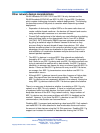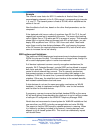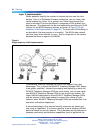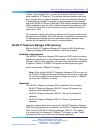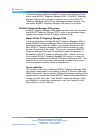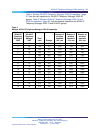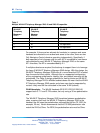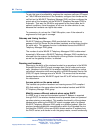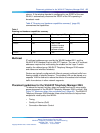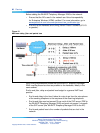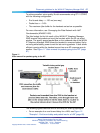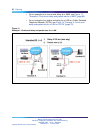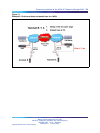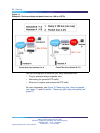
WLAN IP Telephony Manager 2245 planning 63
The handsets encapsulate their voice payloads in SVP for QoS. The
handsets further synchronize communications, so that the handsets are
able to avoid collisions with each other more effectively than the usual
802.11 collision avoidance mechanisms. Each handset maintains a list
of up to four APs as potential candidates for roaming. The handsets are
aggressive in roaming to other APs, which tends to prevent them from using
a suboptimal data rate when another AP can provide better service. The
handsets also communicate with the WLAN IP Telephony Manager 2245
and discover which APs are at full call capacity, so that the handsets can
direct their calls through an AP that has call capacity available.
Under optimal conditions, meaning no interference and all devices in
proximity of the AP, up to 10 voice calls from a handset are supported
on a single AP 2330. When configuring the maximum call parameter of
a WLAN IP Telephony Manager 2245, never configure it above 10. A
more realistic rule of thumb that allows for devices to move about and rate
scale accordingly is anywhere from six to eight calls per AP. A noisy RF
environment can impact the numbers further.
To provide data devices some amount of guaranteed bandwidth, lower the
maximum voice calls per AP to prevent voice calls from consuming all
available throughput. For example, limiting the maximum calls per AP to
seven allows data traffic to reserve up to 30 per cent of media capacity. If
the network supports other handset calls on the 802.11b network, you must
leave adequate capacity for those calls too. Note that the call admission
control function of the WLAN IP Telephony Manager 2245 cannot serve to
limit those other voice calls on a per-AP basis.
There is an alternative control on the WLAN IP Telephony Manager 2245
that affects call capacity across APs. This control allows the WLAN IP
Telephony Manager 2245 to fix the data rates that handsets use. The
options are Automatic and 1 Mb/2 Mb only. When you choose the latter,
maximum call capacity drops by slightly more than half if G.711 is in use, or
by slightly more than two-thirds if G.729 is in use. Most of the variability of
call capacity is removed as rate scaling effects are eliminated. Therefore,
you can get more predictable call capacity at the expense of maximum
number of calls under optimum conditions. Note that with this option
enabled, throughput for 802.11b data devices is severely impacted by even
one or two voice calls.
If the automatic option to have higher potential capacity is selected, there
is a risk of occasionally being oversubscribed under the worst conditions.
For example, if eight calls is the configured limit on the WLAN IP Telephony
Manager 2245, and if all eight calls are from handsets on the edge of
coverage, the cell is oversubscribed. If five calls is the configured limit
and handsets are restricted to 1 Mb/2 Mb, capacity is wasted when most
handsets are close that could otherwise be used by other data devices.
Nortel Communication Server 1000
WLAN IP Telephony Installation and Commissioning
NN43001-504 01.02 Standard
Release 5.0 15 June 2007
Copyright © 2004-2007, Nortel Networks
.



